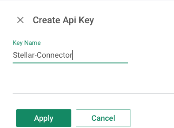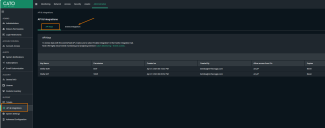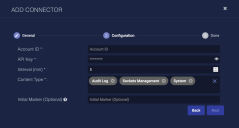Configuring Cato Networks Connectors 
Connectors allow Stellar Cyber to collect data from external sources and add it to the data lake. You create one instance of this connector for each Cato Networks account you want to monitor.
Stellar Cyber connectors with the Collect function (collectors) may skip collecting some data when the ingestion volume is large, which potentially can lead to data loss. This can happen when the processing capacity of the collector is exceeded.
Connector Overview: Cato Networks
Capabilities
-
Collect: Yes
-
Respond: No
-
Native Alerts Mapped: No
-
Runs on: DP
-
Interval: Configurable
Collected Data
|
Content Type |
Index |
API |
|---|---|---|
| Security | Syslog |
This connector uses a single API call to retrieve records that are then parsed for the event_type field to identify the content type. For the content types configured in the connector, the records are saved and tagged with the appropriate msg_class (see Locating Records, below).
using these parameters:
|
| Connectivity | ||
| Sockets Management | ||
| Routing | ||
| System | ||
| Audit |
Domain
|
https://api.catonetworks.com/ |
Response Actions
N/A
Third Party Native Alert Integration Details
N/A
Required Credentials
Collection requires a Cato Networks Account ID with an Editor role, an API key, and the account must also be enabled to Enable integration with Cato events.
Locating Records
Use the following fields as a guide to query for records:
-
msg_origin.source:
cato_networks -
msg_origin.vendor:
cato_networks -
msg_origin.category:
sase -
msg_class:
cato_security, cato_connectivity, cato_sockets_management, cato_routing, cato_system, cato_audit
Let us know if you find the above overview useful.
Adding a Cato Networks Connector
To add a Cato Networks connector:
Enabling Cato API Access
As part of this procedure, you specify the credentials of an account on the Cato server that will be used to retrieve data.
-
Log in to your Cato Networks account as the user you want to monitor.
-
Display the user's profile to verify the account type. Click the user button at the top right of the console, and then clicking My Profile. The user role must be Editor.
-
Obtain the Account ID by noting the URL that displays when the console loads.
-
Navigate to Administration > API Management.
-
Click the button for a New key.
-
In the dialog that displays, enter an identifying Name for the key, then click Apply.
-
When the key is created, a dialog with the value displays. Click the Copy button to copy your API key and ensure you save it to a secure location.
After you close the dialog you can no longer access the value of the API key.
-
Click OK to close the API key dialog.
Enable Event Integration
To send Cato events data to a third party application:
-
Navigate to Administration > API & Integrations.
-
In API & Integrations, click the API Keys tab and then Events Integration.
-
In Events Integration, toggle Enable integration with Cato events to enabled.
Adding the Connector in Stellar Cyber
To add the Cato Networks connector in Stellar Cyber:
-
Log in to Stellar Cyber.
-
Click System | Integration | Connectors. The Connector Overview appears.
-
Click Create. The General tab of the Add Connector screen appears. The information on this tab cannot be changed after you add the connector.
The asterisk (*) indicates a required field.
-
Choose SASE from the Category drop-down.
-
Choose Cato Networks from the Type drop-down.
-
For this connector, the supported Function is Collect, which is enabled already.
-
Enter a Name.
Notes:- This field does not accept multibyte characters.
- It is recommended that you follow a naming convention such as tenantname-connectortype.
-
Choose a Tenant Name to specify which tenant is permitted to use this connector on Stellar Cyber.
-
Choose the device on which to run the connector .
-
(Optional) When the Function is Collect, you can apply Log Filters. For information, see Managing Log Filters.

-
Click Next. The Configuration tab appears.
The asterisk (*) indicates a required field.
-
Enter the Account ID you obtained from the Cato Networks login, above.
-
In the API Key field, enter the value you saved above.
-
Enter the Interval (min). This is how often the logs are collected.
-
Select the Content Type:
- Audit Log
- Connectivity
- Routing
- Security
- Sockets Management
- System
-
(Optional) This Initial Marker field is used to adjust the ingestion start point in cases where the volume of Event data to retrieve is extremely large. (The default duration Cato Network’s API retrieves is 7 days of Event data.) The API supporting this field requires an encoded base64 string (combining topic, partition, and offset) that is unique to your active events queue. Stellar Cyber has provided this field for use only by advanced API users of Cato Networks who are already familiar with retrieving this marker value in their environment. (This marker does not apply to Audit type data.)
-
Click Next. The final confirmation tab appears.
-
Click Submit.
The new connector is immediately active.
Testing the Connector
When you add (or edit) a connector, we recommend that you run a test to validate the connectivity parameters you entered. (The test validates only the authentication / connectivity; it does not validate data flow).
For connectors running on a sensor, Stellar Cyber recommends that you allow 30-60 seconds for new or modified configuration details to be propagated to the sensor before performing a test.
-
Click System | Integrations | Connectors. The Connector Overview appears.
-
Locate the connector that you added, or modified, or that you want to test.
-
Click Test at the right side of that row. The test runs immediately.
Note that you may run only one test at a time.
Stellar Cyber conducts a basic connectivity test for the connector and reports a success or failure result. A successful test indicates that you entered all of the connector information correctly.
To aid troubleshooting your connector, the dialog remains open until you explicitly close it by using the X button. If the test fails, you can select the button from the same row to review and correct issues.
The connector status is updated every five (5) minutes. A successful test clears the connector status, but if issues persist, the status reverts to failed after a minute.
Repeat the test as needed.
If the test fails, the common HTTP status error codes are as follows:
| HTTP Error Code | HTTP Standard Error Name | Explanation | Recommendation |
|---|---|---|---|
| 400 | Bad Request | This error occurs when there is an error in the connector configuration. |
Did you configure the connector correctly? |
| 401 | Unauthorized |
This error occurs when an authentication credential is invalid or when a user does not have sufficient privileges to access a specific API. |
Did you enter your credentials correctly? Are your credentials expired? Are your credentials entitled or licensed for that specific resource? |
| 403 | Forbidden | This error occurs when the permission or scope is not correct in a valid credential. |
Did you enter your credentials correctly? Do you have the required role or permissions for that credential? |
| 404 | Not Found | This error occurs when a URL path does not resolve to an entity. | Did you enter your API URL correctly? |
| 429 | Too Many Requests |
This error occurs when the API server receives too much traffic or if a user’s license or entitlement quota is exceeded. |
The server or user license/quota will eventually recover. The connector will periodically retry the query. If this occurs unexpectedly or too often, work with your API provider to investigate the server limits, user licensing, or quotas. |
For a full list of codes, refer to HTTP response status codes.
Verifying Ingestion
To verify ingestion:
-
Click Investigate | Threat Hunting. The Interflow Search tab appears.
-
Change the Indices to Syslog. The table immediately updates to show ingested Interflow records.













